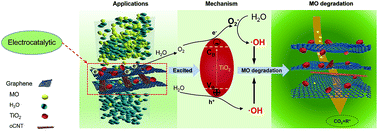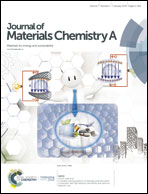A novel 3-dimensional graphene-based membrane with superior water flux and electrocatalytic properties for organic pollutant degradation
Abstract
Graphene-based separation membranes exhibit great potential for the application of wastewater purification, but it is difficult to achieve a balance between water flux and rejection. To overcome the “trade-off” effect between permeability and selectivity, a novel 3-dimensional graphene-based membrane with superior water flux was fabricated using a simple, viable and green method. In addition, electrocatalytic technology is coupled to the membrane separation process. Comprehensive characterization indicates that the TiO2 nanoparticles were successfully mounted on the moderately reduced graphene oxide (rGO) surface. By introducing oxygen-functionalized carbon nanotubes (oCNTs), the rGO-TiO2/oCNT membrane has more pronounced 3-dimensional water channels. More importantly, the rGO-TiO2/oCNT membrane acts as both a separation membrane and an anode to couple the membrane process to the electrocatalytic technique. The small-molecule contaminants that are difficult to remove by physical exclusion would be degraded when the matter passes through the channels with the electrocatalyst. The TiO2 nanoparticles act as both a nano-wedge to expand the water channels and an electrocatalyst to promote the degradation of the contaminants. The rGO-TiO2/oCNT membranes showed a removal rate up to 95% at a high liquid hourly space velocity of 88 h−1 under the applied electrocatalysis conditions, which is two times more than that obtained without the electrocatalyst. The rGO-TiO2/oCNT membrane could not only achieve a superior water flux (the maximum was 44.14 L m−2 h−1 bar−1) but also maintain excellent dye removal performance (>90%) via membrane process coupling electrocatalysis. The optimum component ratio of the rGO-TiO2/oCNT membrane was investigated, and it was found that 30% oCNT content accounts for a stable catalytic performance. The graphene-based membrane coupled electrocatalysis in this study would provide a new approach to break the bottleneck of the trade-off effect and inspire the design of a functional membrane.



 Please wait while we load your content...
Please wait while we load your content...